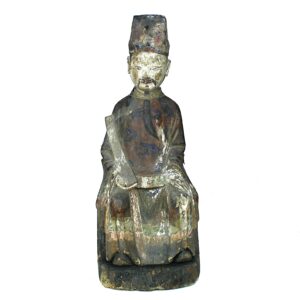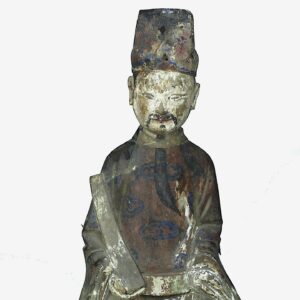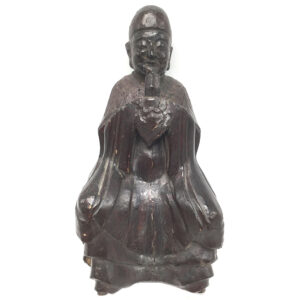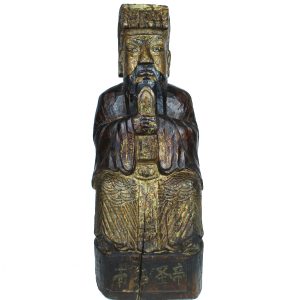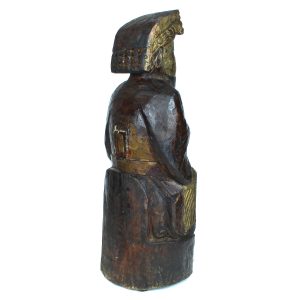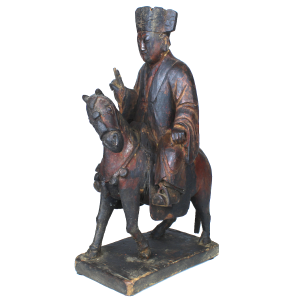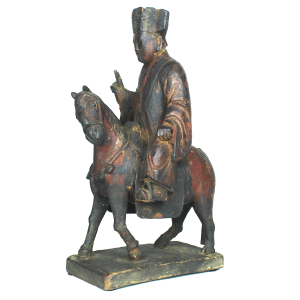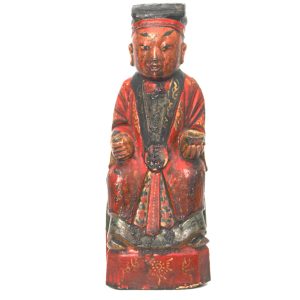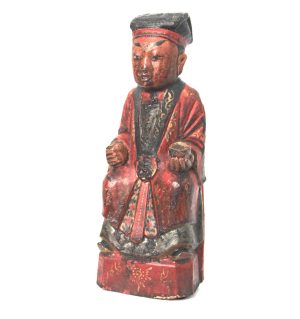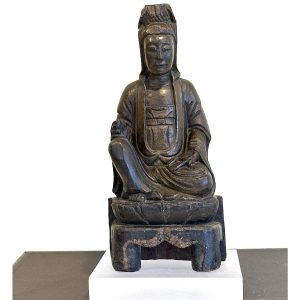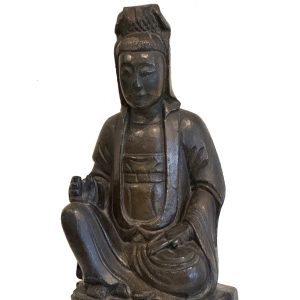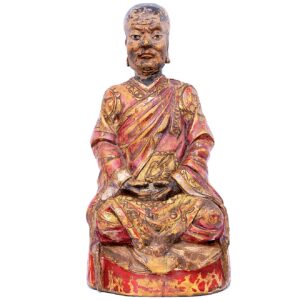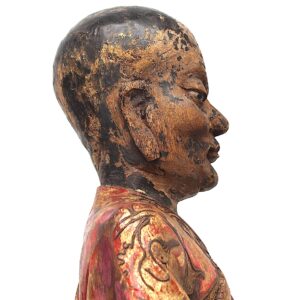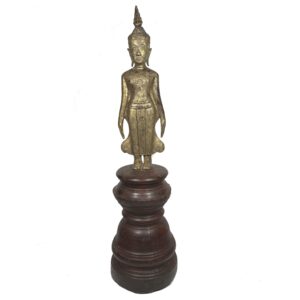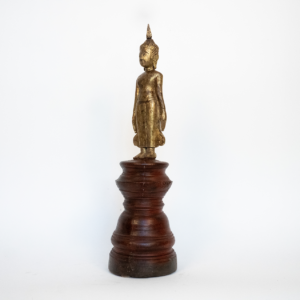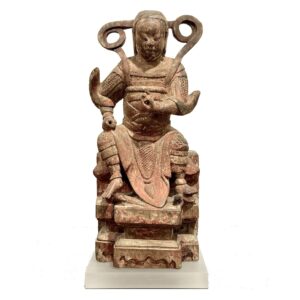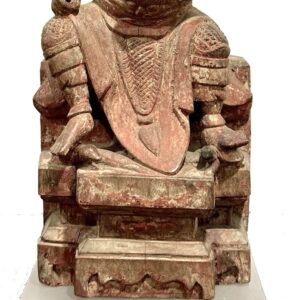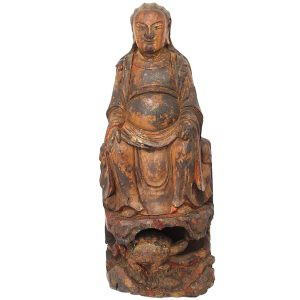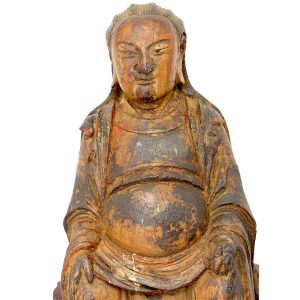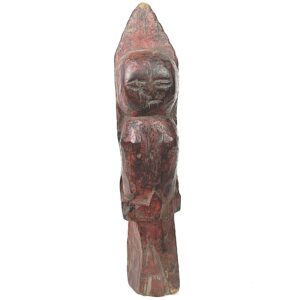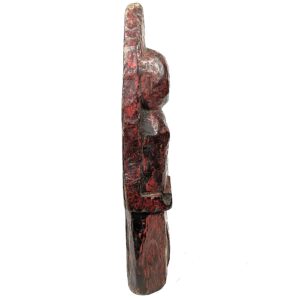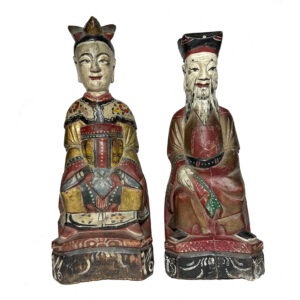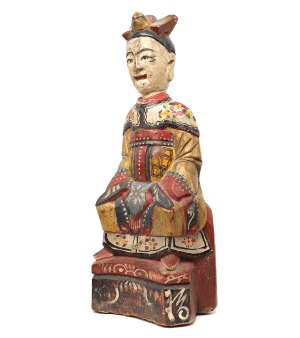Showing 121–132 of 248 results
-
Sale!


$295.00 Original price was: $295.00.$215.00Current price is: $215.00.
H: 12.875″ W: 5″ D: 2.75″ | FREE SHIPPING WITHIN CONTINENTAL U.S.
Probably placed on a home altar with other carving, this Taoist official holds a long, curved hu, wearing a high hat, collared robe with painted cobalt blue clouds and official’s belt. Consecrated with original script inside.
-
Sale!


$295.00 Original price was: $295.00.$215.00Current price is: $215.00.
H: 10.5″ W:5″ D: 4″ | FREE SHIPPING WITHIN CONTINENTAL U.S.
Taoist official/priest on backless chair, arms at chest and hands covered by ritual cloth symbolically holding a hu tablet. Darkened by incense and candle smoke from ritualistic offerings it was re-lacquered probably in early 20th-century.
-
Sale!


$395.00 Original price was: $395.00.$295.00Current price is: $295.00.
When ancestral images are taken out of context they are very difficult to identify so we describe them in generic terms as a Chinese Officials or Taoist Officials. This carving may represent the noted historical figure the principal regent Dorgon of the first Qing Emperor Shunzhi who ruled from 1643-1650 as a”quasi” emperor based on…
-
Sale!


$795.00 Original price was: $795.00.$595.00Current price is: $595.00.
H: 13″ W: 4″ D: 7″ | FREE SHIPPING WITHIN CONTINENTAL U.S.
Taoist priest wearing a winged hat with a taotie warning against excess, and hands in the Sword Gesture used to cast out evil and offer blessings. Often on horses, priests were models of morality reflecting the Way of the Tao stressing harmony and oneness with nature.
-
Sale!


$295.00 Original price was: $295.00.$195.00Current price is: $195.00.
H: 7.25″ W: 2.75″ D :2″ | FREE SHIPPING WITHIN CONTINENTAL U.S.
Colorful Taoist priest carving holding a cup with the Elixir of Life granting eternal life. Red is the color of fu to bring into the home divine favors. Whimsically painted face and raised lacquer decorations, it was consecrated and originally placed on a home altar.
-
Sale!


$785.00 Original price was: $785.00.$625.00Current price is: $625.00.
H: 10.75″ W: 5.5″ D: 4.5″ | FREE SHIPPING IN CONTINENTAL U.S.
White clad Guanyin in royal ease and karana mudra to expel evil, remove problems and rid sickness or other negativities rarely used for Guanyin. Consecrated for home altar use.
-


$785.00
18 original Lohans were the major disciples of Shakyamuni Buddha whom he, at his death bed, entrusted to protect and promulgate Buddhist teachings. Over centuries, their numbers increased to over 500 enlightened beings recognized for their courage and supernatural powers. In Mahayana Buddhism, Lohans represent the ideal toward which Buddhist devotees should strive as they…
-


$1,575.00
H: 24.5” Dia: 7″ | CALL 213-568-3030 FOR SHIPPING quote or email [email protected]
Lao carved Buddha statues are renowned for their delicacy and refinement. This elegant antique Buddha is depicted in the “Calling for Rain” mudra found only in Laos with his half-closed gazing downward in meditation, elegant gestures, lyrical flaring robes and graceful curves of the body reflecting the Buddha’s gentleness. The curvature, proportions and oversized head indicate the perfection, wisdom and compassion of the “Enlightened One. He stands on a multi-tiered circular and waisted base. Carved Laotian images as old and elegant as this are rare.
-
Sale!


$1,250.00 Original price was: $1,250.00.$975.00Current price is: $975.00.
H: 15.25″ W: 6.75″ D: 6.75″ |CALL 213-568-3030 OR EMAIL [email protected] FOR SHIPPING
Zhenwu (Perfected Warrior) one of most important and powerful Taoist deities, is revered for magical powers to suppress demonic forces. Forceful wood provincial image for personal devotion reflecting his iconography: on throne, bare feet resting on snake and tortoise, celestial scarf and maille armor.
-
Sale!


$575.00 Original price was: $575.00.$495.00Current price is: $495.00.
H: 13″ W: 5″ D: 4.8″ | FREE SHIPPING WITHIN CONTINENTAL U.S.
Provincial carving of Zhenwu the Perfected Warrior, one of the most popular Taoist deities in the Ming/Qing dynasties, iconically shown standing on a snake and turtle, symbolizing those over whom he presides.
-
Sale!


$85.00 Original price was: $85.00.$55.00Current price is: $55.00.
Ht: 9..5 ” W: 2″ D:1.5 ” | FREE SHIPPING WITHIN CONTINENTAL U.S.
Antique carving of a Devi (Sanskrit: divine) probably a child’s toy and and protective item. Tikka on forehead, ample breasts – a wish for fertility with a shiny patina from use.
-
Sale!


$785.00 Original price was: $785.00.$625.00Current price is: $625.00.
H: Tudi Gong: 11.75″. Tudi Po 12.37″ | CALL 213-568-3030 OR EMAIL [email protected] FOR SHIPPING.
This happy benevolent couple are Taoist Earth God Tudi Gong and his wife Tudi Po placed on a home altar to assure an abundant harvest. Referred to as “Grandpa” and “Grand Ma” they wear vibrant Mandarin official’s attire, him with a mandarin square with a bird, and her with a phoenix headdress.
End of content
End of content

